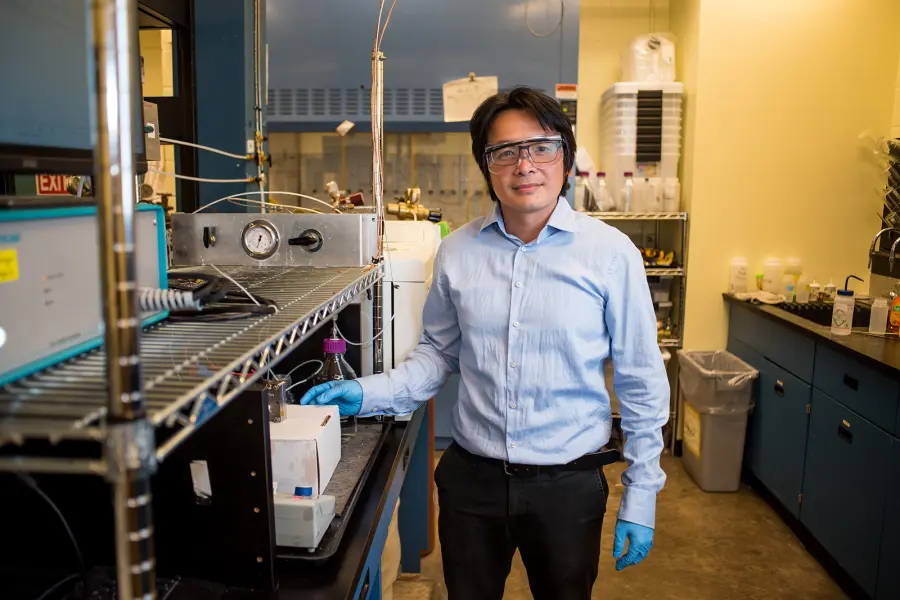Carbon dioxide (CO2) is critical to how we live our lives, but it is also one of the world’s main pollutants. For decades, both researchers and climate activists have been warning about the damage it can cause to the planet.
Sustainability plans and goals often focus on reducing CO2 emissions, which is crucial to avoid a climate catastrophe. A different and complementary approach is also on the horizon: to capture carbon dioxide from the atmosphere and turn it into useful and sustainable products.
Cao Thang Dinh, an assistant professor in Chemical Engineering, has developed technology to capture and convert CO2 into valuable chemicals and fuels using renewable energy.

What are your overall research goals?
My lab’s current focus is carbon dioxide conversion technology, which has multiple advantages and the potential to solve some key world problems.
Worldwide, we emit around 40 million tons of CO2 every year, and one of our biggest challenges is how to reduce CO2 levels in the air. We are working on a technology that will enable us to do exactly that. Our first goal is to convert carbon dioxide into chemicals like methane, methanol and ethanol that can be used as fuels.
A second goal is to develop technology to use carbon dioxide as a precursor to produce other chemicals, like polymers – big molecules that we use to produce plastics, nylon, silicone, and other materials. We currently make polymers from fossil fuel precursors. If we can use CO2, we can make these materials more sustainable.
Lastly, an important aspect of our research is that we are looking for ways to convert electricity and green energy sources, like wind or solar energy, into liquid fuel that can be easily stored with current infrastructures. This would solve another huge challenge.
What are the main challenges in developing new carbon dioxide conversion technology?
Improving efficiency is one of them. We produce CO2 every time we burn fuels, and CO2 is a very stable molecule. To convert it into something new, we need energy: producing one liter of fuel from CO2 requires a lot of electricity, so high energy efficiency is a critical requirement.
The other challenge is how to control the conversion of CO2 into the desired molecules. Carbon dioxide can be converted into many different molecules in a single process. This is great opportunity to produce a variety of products. However, we need to make sure we are being selective on what we are producing – otherwise, we will have to spend a lot of energy purifying the final product.
How is the technology you are proposing different from existing technologies?
There are research groups working on technology to capture carbon dioxide from the air or from power plant exhausts. And there’s technology for CO2 conversion. But what we are trying to achieve is to combine both processes in the same system to significantly reduce the amount of energy needed for CO2 capture and conversion.
We’ve built an integrated system capable of capturing and converting carbon dioxide, with higher energy efficiency. We are also working on solutions to improve selectivity in the CO2 conversion to various products.
When can we expect this new technology to be available?
That will depend on the kind of molecules we are hoping to produce from CO2. For simpler molecules, like carbon monoxide or formic acid, the technology is already advanced and there are some startups working on making this technology available, although it is still an expensive technology. I would say in the next three to five years we will see the scale-up of products using this technology.
For more complex products, it can take longer.
We want to use this technology to produce fuels like ethanol or a precursor to make plastics like polyethylene. As an example, it could be used to produce plastic bottles, which is a huge market. However, the technology to make these is not yet advanced.
Are there other areas where your work have potential impact?
Yes. We can apply the same principles we use in carbon dioxide conversion to other molecules. We have a project with an industrial partner where we convert the oxygen in the air into hydrogen peroxide and then incorporate it into a wastewater treatment system. We are also exploring how to produce different chemicals for agricultural purposes. One project we are working on is to convert CO2 and nitrogen from the air to produce urea – a widely used fertilizer.
What excites you most about the possibility of this technology?
Imagine that we can produce fuels, materials, and fertilizers in a sustainable and distributed way from solar, wind, air, and water, which are available almost everywhere. This would provide access to clean energy, water, and food to everyone – a truly sustainable world.